Kerala Black Halwa: A Sweet Indulgence with Deep Roots in Kerala’s Culture
Kerala Halwa, a chewy, flavorful treat, holds a special place in the hearts of Keralites. Known for its rich taste and smooth texture, this traditional dessert is synonymous with festivals and celebrations across Kerala. Among the different varieties, Kerala Black Halwa stands out due to its deep, dark color, glossy finish, and decadent taste. In this article, we’ll dive into the origins, preparation, and cultural significance of this beloved dessert.
The Origins and Cultural Significance of Kerala Halwa
The history of Kerala Halwa can be traced back to the trade routes that connected Kerala with Arab traders. Influenced by Persian and Arab sweets, Kerala Halwa evolved into a unique culinary creation that reflects the tropical ingredients and flavors of the region. Today, it is a staple during festivals like Onam and Vishu, and is even gifted as a souvenir by tourists visiting Kerala. The town of Kozhikode (Calicut) is especially famous for its halwa shops, where rows of colorful halwas, including the renowned Black Halwa, are displayed like edible jewels.
Halwa plays a vital role in Kerala’s culture. It is more than just a dessert; it’s a symbol of hospitality, family gatherings, and celebrations. From weddings to religious festivals, Kerala Halwa is always present, bringing people together to share in the joy of tradition and taste.
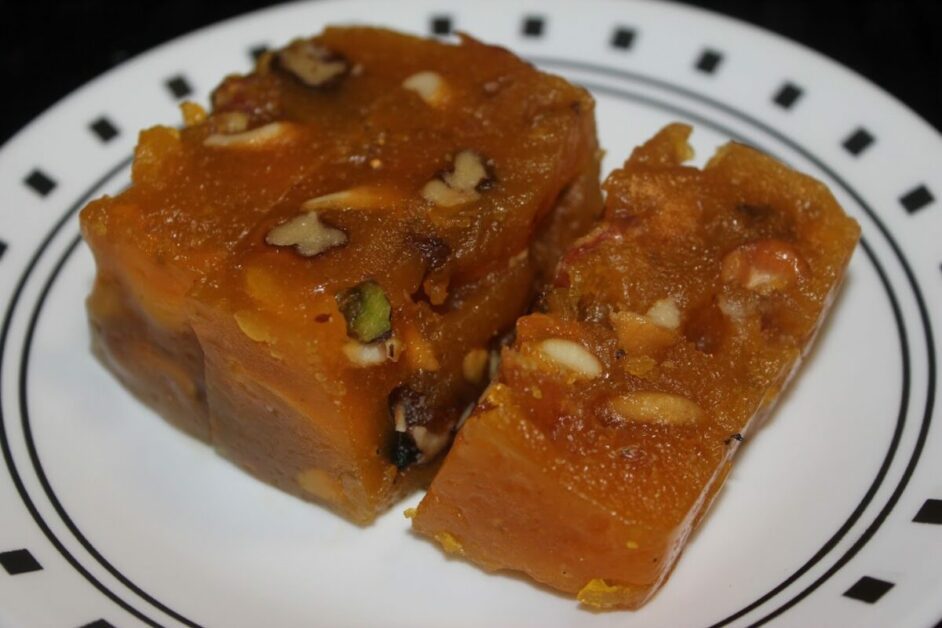
What is Kerala Halwa?
Kerala Halwa is a unique confectionery made from rice flour, coconut milk, ghee, and sugar or jaggery. It’s cooked slowly, with constant stirring, to achieve its signature chewy texture and glossy appearance. One of the key features of Kerala Halwa is its versatility—there are numerous varieties, each offering a different flavor experience.
Popular Varieties of Kerala Halwa
Kerala Halwa is known for its rich variety, each offering a unique taste and texture. The diversity of ingredients and preparation techniques across Kerala makes every halwa special. Below are some of the most popular varieties of Kerala Halwa, each with its distinct flavor and characteristics.
1. Kerala Black Halwa
Kerala Black Halwa, also known as Karutha Halwa, is the most iconic variety. Made with jaggery, rice flour, and coconut milk, this halwa is known for its glossy dark appearance and rich flavor. The use of jaggery gives it a molasses-like sweetness, which is perfectly balanced with the creamy coconut milk and ghee. The chewy texture and the long, slow cooking process ensure that Black Halwa is full of deep, complex flavors. This variety is a staple at festivals and special occasions, particularly in Kozhikode.
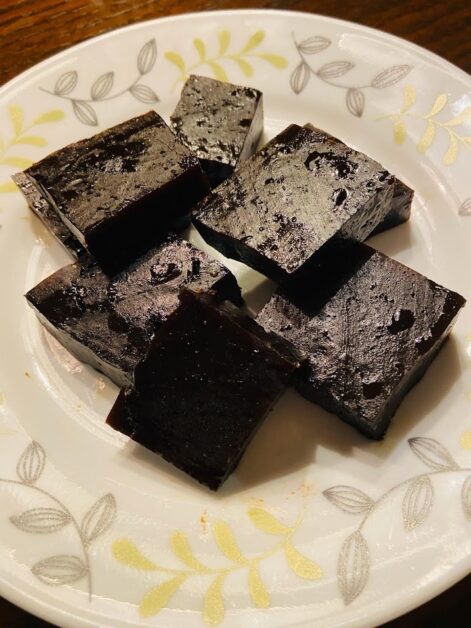

2. Banana Halwa
Banana Halwa is a fruity variation of Kerala Halwa made from ripe bananas. Known for its natural sweetness and soft texture, Banana Halwa offers a distinct flavor profile with a tropical twist. The bananas are mashed and combined with ghee, sugar, and cardamom to create a smooth, dense halwa that melts in your mouth. The addition of coconut makes it even richer and perfect for those who prefer a sweeter and lighter alternative to Black Halwa.
3. Kerala Mixed Fruit Halwa
Kerala Mixed Fruit Halwa combines a variety of fruits, such as pineapple, mango, papaya, and banana, to create a colorful and flavorful treat. Each fruit contributes its natural sweetness and flavor, resulting in a halwa that bursts with fruity notes in every bite. The use of coconut milk and ghee enhances the richness of this dessert, making it a perfect choice for those who enjoy a diverse and fruity flavor profile. This variation is often enjoyed during festivals and is popular among both locals and tourists.
4. Papaya Halwa
Papaya Halwa is a unique variety that utilizes the natural sweetness and vibrant color of ripe papayas. The papaya is cooked down with ghee, sugar, and a touch of cardamom to create a halwa that is smooth, sweet, and slightly tangy. The tropical flavor of papaya gives this halwa a refreshing twist compared to traditional Kerala Halwa. It’s an excellent option for those looking for a lighter, fruit-based dessert that still packs a flavorful punch.
5. Red Halwa
Red Halwa is a lighter alternative to Black Halwa, made using white sugar instead of jaggery. This results in a milder sweetness and a bright, reddish color. While it shares the chewy texture of traditional Kerala Halwa, Red Halwa has a more delicate taste, making it a popular choice for those who prefer a less intense sweetness. It is often garnished with nuts like cashews or almonds to add a crunchy texture.
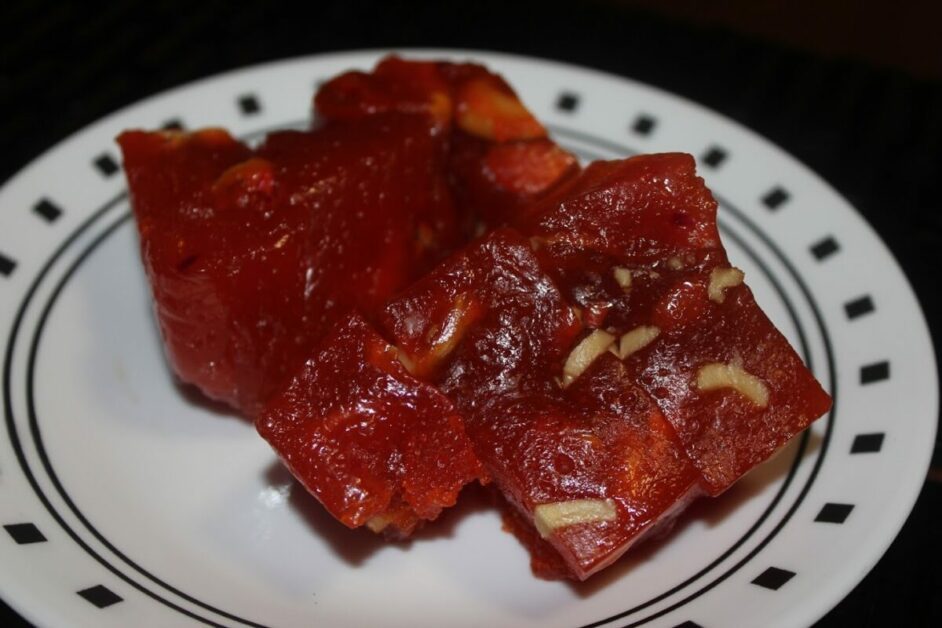
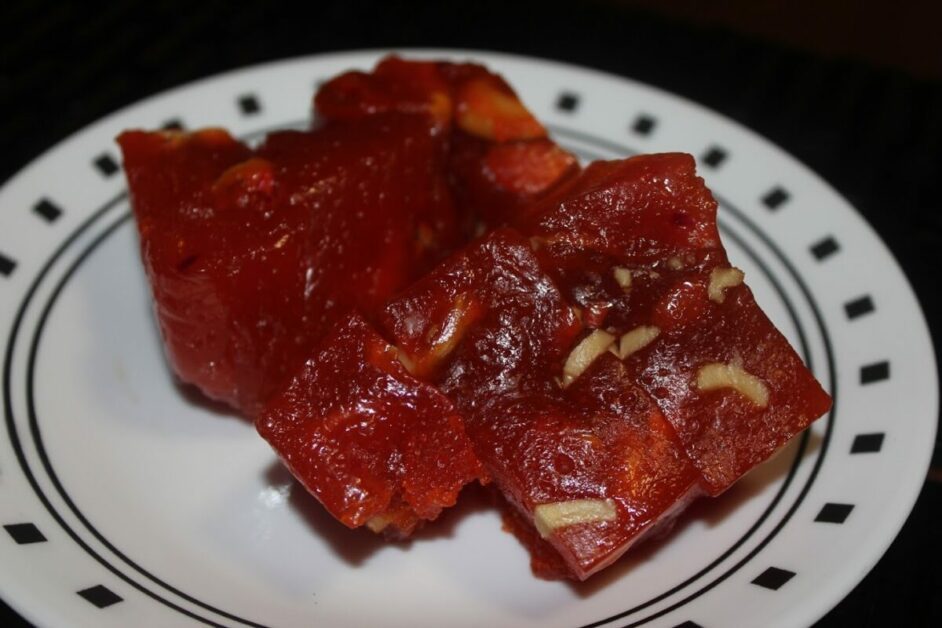
6. Wheat Halwa
Wheat Halwa is crafted using wheat flour and ghee, giving it a smooth, nutty flavor. This halwa is rich in texture and has a denser consistency than other varieties. The combination of ghee and wheat flour, along with sugar or jaggery, results in a halwa that is both sweet and slightly earthy. Wheat Halwa is often made during special occasions and is loved for its rich, wholesome taste.
7. Arrowroot Halwa (Koova Vilayicha Halwa)
Arrowroot Halwa, also known as Koova Vilayicha Halwa, is a lighter version of the traditional Kerala Halwa, made using arrowroot flour instead of rice flour or wheat flour. This halwa has a silky texture and is often flavored with cardamom and garnished with nuts. The use of arrowroot flour gives this halwa a translucent appearance and a smoother, jelly-like consistency. It is particularly popular among those who prefer a less chewy and more delicate dessert.
8. Carrot Halwa
Carrot Halwa is a colorful and nutrient-packed variation of Kerala Halwa. Made with grated carrots, milk, ghee, and sugar, this halwa is a popular choice during winter months when carrots are in season. The natural sweetness of the carrots is enhanced by the rich ghee and milk, creating a dessert that is both sweet and slightly savory. The bright orange color and the soft texture make Carrot Halwa an appealing option for those looking for a visually vibrant and flavorful treat.
9. Jackfruit Halwa
Jackfruit Halwa is a tropical twist on the traditional Kerala Halwa. Made with the pulp of ripe jackfruits, this halwa is intensely sweet and fragrant. The natural sugar in the jackfruit gives this dessert a caramel-like flavor, while the addition of ghee and coconut milk adds richness and depth. Jackfruit Halwa is a seasonal delicacy, typically made when jackfruits are in abundance. It’s a perfect choice for those who enjoy fruity, fragrant desserts.
10. Coconut Halwa
Coconut Halwa emphasizes the use of coconut, one of Kerala’s most iconic ingredients. This halwa is rich, creamy, and bursting with the flavor of fresh coconut. Coconut milk and grated coconut are combined with ghee and sugar to create a dessert that is both smooth and chewy. The addition of cardamom enhances the flavor, making this halwa a favorite among coconut lovers. It is often enjoyed during festivals like Onam and is cherished for its authentic, tropical taste.
11. Cashew Nut Halwa
Cashew Nut Halwa is a rich and decadent variety that is packed with the nutty flavor of cashews. Ground cashews are blended with ghee, sugar, and milk to create a smooth, luxurious halwa that is perfect for special occasions. The cashews add a delightful crunch, while the ghee and milk provide creaminess, making this halwa an indulgent treat. It is often served at weddings and other celebrations due to its rich taste and elegant appearance.
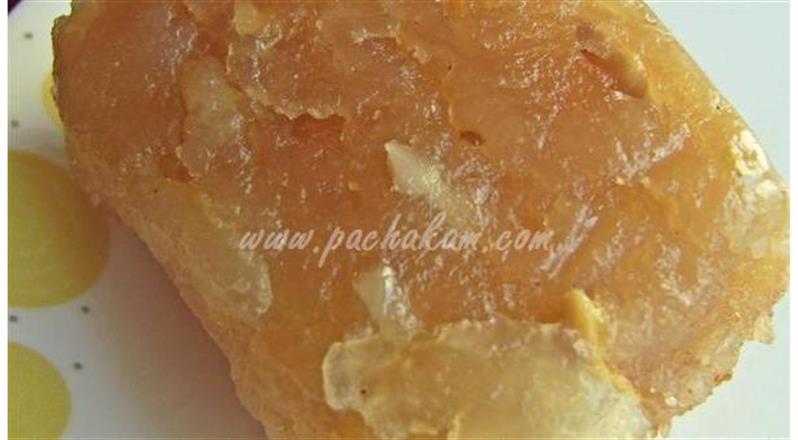

12. Sooji Halwa
Sooji Halwa, also known as Rava Halwa, is made with semolina (sooji), which gives it a grainy texture and a delicate flavor. The semolina is roasted in ghee and then cooked with sugar and water or milk to create a halwa that is both light and satisfying. Sooji Halwa is often flavored with cardamom and garnished with nuts, making it a popular choice for breakfast or as a quick dessert.
13. Rava Halwa
Similar to Sooji Halwa, Rava Halwa is made with finer semolina, which results in a smoother texture. This variation of Kerala Halwa is softer and has a melt-in-the-mouth quality. It is often flavored with saffron or cardamom and garnished with raisins and nuts. Rava Halwa is a lighter, more delicate option for those who prefer a less dense dessert.
14. Caramel Halwa
Caramel Halwa is a rich and indulgent variety that features caramelized sugar for a deep, rich flavor. The caramel adds a toasty, slightly bitter note that balances the sweetness of the halwa. Combined with ghee and coconut milk, Caramel Halwa offers a complex flavor profile that appeals to those who enjoy desserts with a rich, layered taste.
15. Gothambu Halwa
Gothambu Halwa is made with wheat flour (gothambu) and sugar, offering a hearty and satisfying dessert. The wheat flour gives this halwa a dense, chewy texture, while the sugar and ghee add sweetness and richness. It is often garnished with nuts or dried fruits, making it a popular choice for festive occasions.
16. Condensed Milk Halwa
Condensed Milk Halwa is a creamy and sweet variation of Kerala Halwa that uses condensed milk for extra richness. The condensed milk gives this halwa a smooth, velvety texture and enhances its sweetness. This version is often made quickly and is perfect for those who prefer a milder, creamier halwa.
Kerala Black Halwa: A Sweet Indulgence with Deep Roots
Kerala Black Halwa, or Karutha Halwa, is one of the most iconic versions of Kerala Halwa. This version stands out due to its rich, molasses-like flavor, which comes from using jaggery instead of sugar. The deep, dark color and glossy finish make it visually striking, while its smooth, chewy texture melts in your mouth with every bite.
What Makes Kerala Black Halwa Special?
- Generous Use of Jaggery: Unlike other varieties that use sugar, Black Halwa relies heavily on jaggery. The quality of jaggery significantly impacts the flavor, giving the halwa its rich, caramel-like taste and dark hue.
- Coconut Milk and Ghee: These two ingredients are key to achieving the halwa’s creamy texture and glossy finish. The coconut milk adds depth to the flavor, while ghee enhances richness.
- Rice Flour Base: Kerala Black Halwa uses rice flour, which contributes to its distinct chewy texture. This sets it apart from wheat-based halwas commonly found in other regions.
Kerala Halwa Recipe: How to Make Kerala Black Halwa at Home
Making Kerala Black Halwa at home is a labor of love. The process requires patience and constant stirring to ensure the mixture doesn’t burn, but the result is worth every effort. Here’s an easy recipe you can make at home:
Ingredients:
- 1 cup rice flour
- 4 cups thick coconut milk (extracted from about 4 coconuts)
- 2 cups jaggery (adjust based on sweetness preference)
- 1 cup ghee (clarified butter)
- ½ cup cashews (optional)
- ¼ cup raisins (optional)
- 1 teaspoon cardamom powder
- A pinch of salt
Step-by-Step Preparation:
- Prepare the Coconut Milk: Extract thick coconut milk from freshly grated coconuts. Strain it using a fine cloth or sieve to ensure a smooth consistency.
- Make Jaggery Syrup: In a pan, melt jaggery with a little water until you get a thick syrup. Strain to remove any impurities.
- Mix the Ingredients: In a large, heavy-bottomed pan, mix the rice flour and coconut milk. Stir continuously to avoid lumps. Once smooth, add the jaggery syrup and mix well.
- Cook the Mixture: Place the pan on medium heat and begin cooking the mixture. Stir constantly to prevent sticking. Gradually add ghee as the mixture thickens.
- Stir Constantly: As the mixture continues to thicken, it will leave the sides of the pan and develop a glossy texture. Continue cooking for about an hour, adding ghee in intervals.
- Add Garnishes: When the halwa thickens and starts to leave the sides of the pan, stir in cardamom powder, cashews, and raisins.
- Set and Serve: Pour the halwa into a greased tray and flatten the top with a spatula dipped in ghee. Let it cool before cutting into pieces.
Tips for Making the Perfect Kerala Black Halwa
- Use Fresh Ingredients: Freshly squeezed coconut milk and high-quality jaggery are crucial for achieving the authentic flavor.
- Patience is Key: The cooking process is time-consuming and requires constant attention. Avoid high heat to prevent burning.
- Generous with Ghee: Don’t skimp on the ghee! It gives the halwa its signature glossy finish and enhances the flavor.
Nutritional Benefits of Kerala Halwa
Though Kerala Halwa is a sweet indulgence, its traditional ingredients offer some nutritional benefits:
- Jaggery is rich in iron and minerals, providing a healthier alternative to refined sugar.
- Coconut Milk is a good source of healthy fats, which can promote heart health.
- Ghee contains fat-soluble vitamins like A, D, E, and K, essential for overall well-being.
- Cashews and Raisins add a nutritional boost, offering antioxidants and essential nutrients.
Kerala Halwa: A Sweet for Every Occasion
Whether it’s a wedding, festival, or just a craving for something sweet, Kerala Halwa is the perfect indulgence. This traditional dessert is more than just a treat; it’s part of Kerala’s cultural fabric, representing hospitality, celebration, and togetherness. From the bustling markets of Kozhikode to homes across the state, halwa brings a taste of tradition to every bite.
Variations of Kerala Halwa
While Black Halwa is undoubtedly a star, Kerala offers a variety of other halwas, each with its unique flavor and appeal:
- Yellow Halwa: Made with pineapples or bananas, this halwa is fruity, vibrant, and perfect for those who prefer a lighter taste.
- Red Halwa: Prepared using a different variety of jaggery and sometimes with added spices, red halwa has a slightly tangier and spicier profile.
- White Halwa: A simpler version made with sugar instead of jaggery, offering a lighter color and a milder taste.
Conclusion
Kerala Black Halwa is a celebration of Kerala’s rich culinary heritage, combining the region’s traditional ingredients with a slow-cooked, meticulous preparation method. The result is a sweet treat that offers a symphony of flavors and textures. Whether made at home or purchased from a halwa shop, this iconic dessert continues to captivate with its timeless appeal.
Frequently Asked Questions
-
Can I store Kerala Black Halwa?
Yes, Black Halwa has a good shelf life due to the high content of ghee and jaggery. It can be stored at room temperature in an airtight container for up to a week or refrigerated for longer.
-
Is Black Halwa gluten-free?
Yes, Kerala Black Halwa is gluten-free as it uses rice flour instead of wheat flour, making it suitable for those with gluten intolerance.

